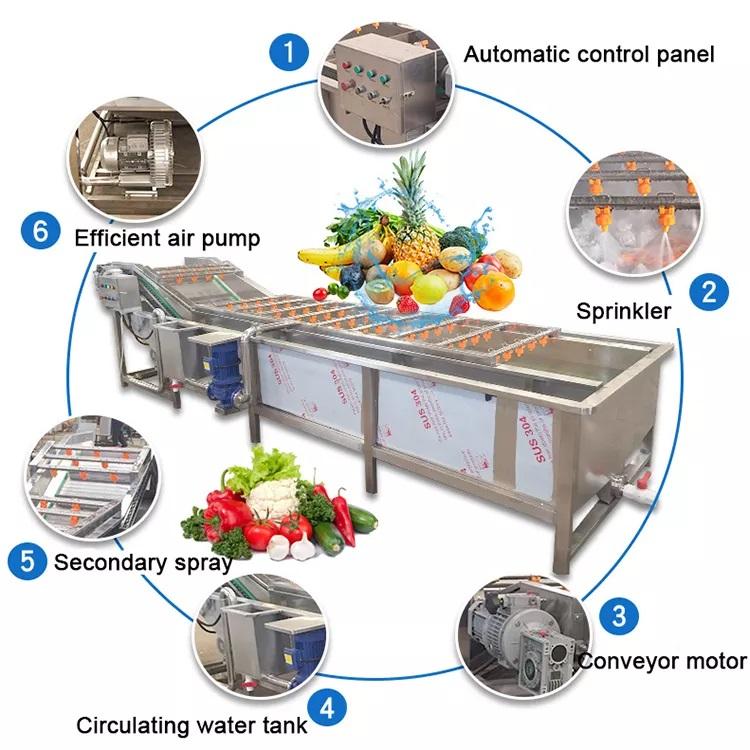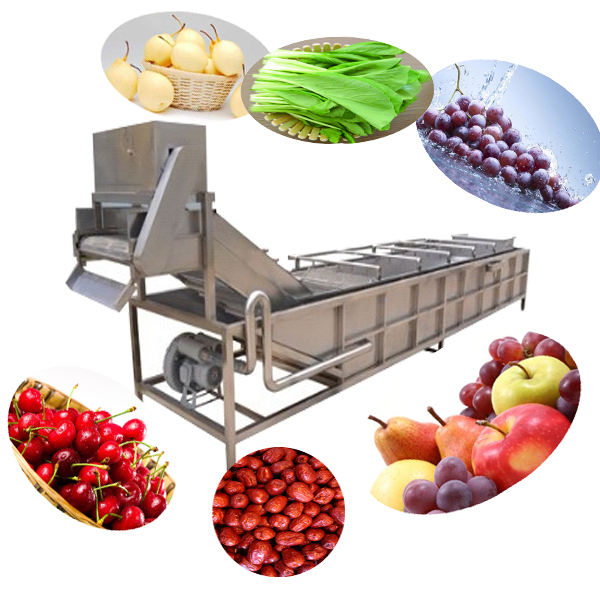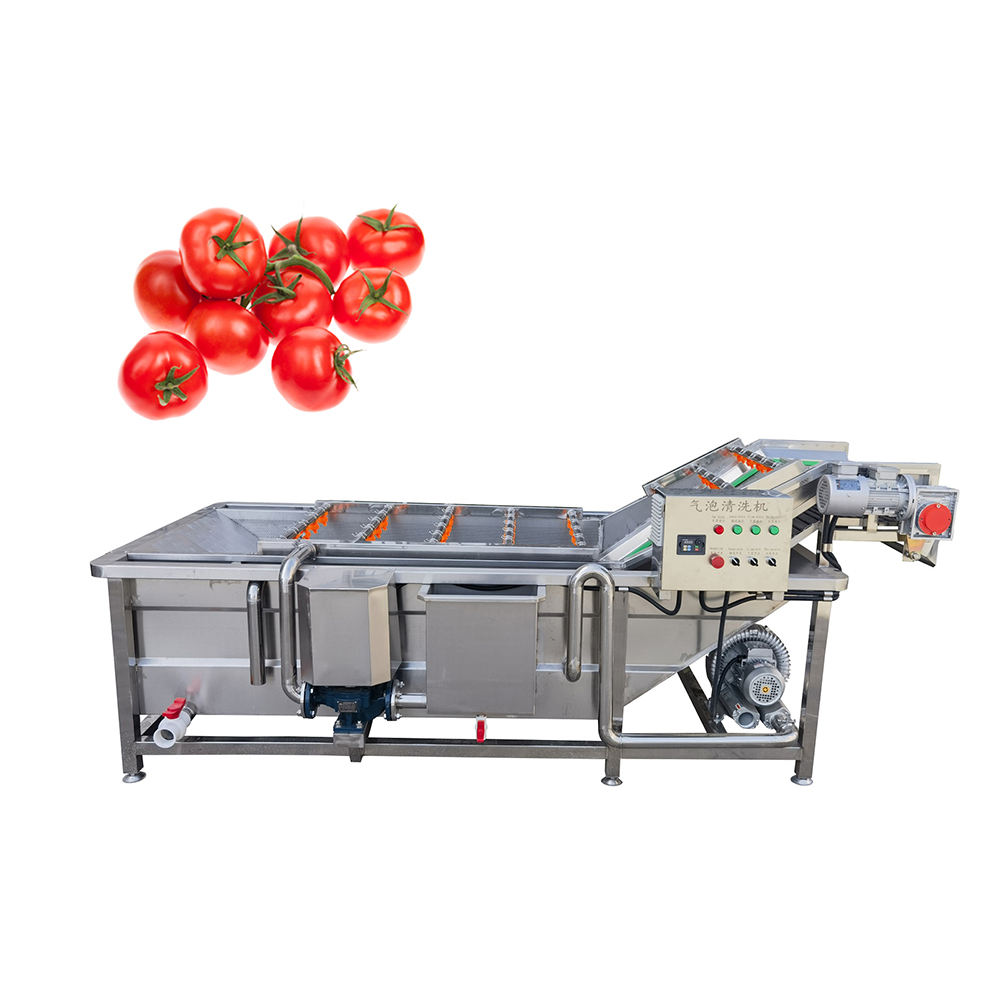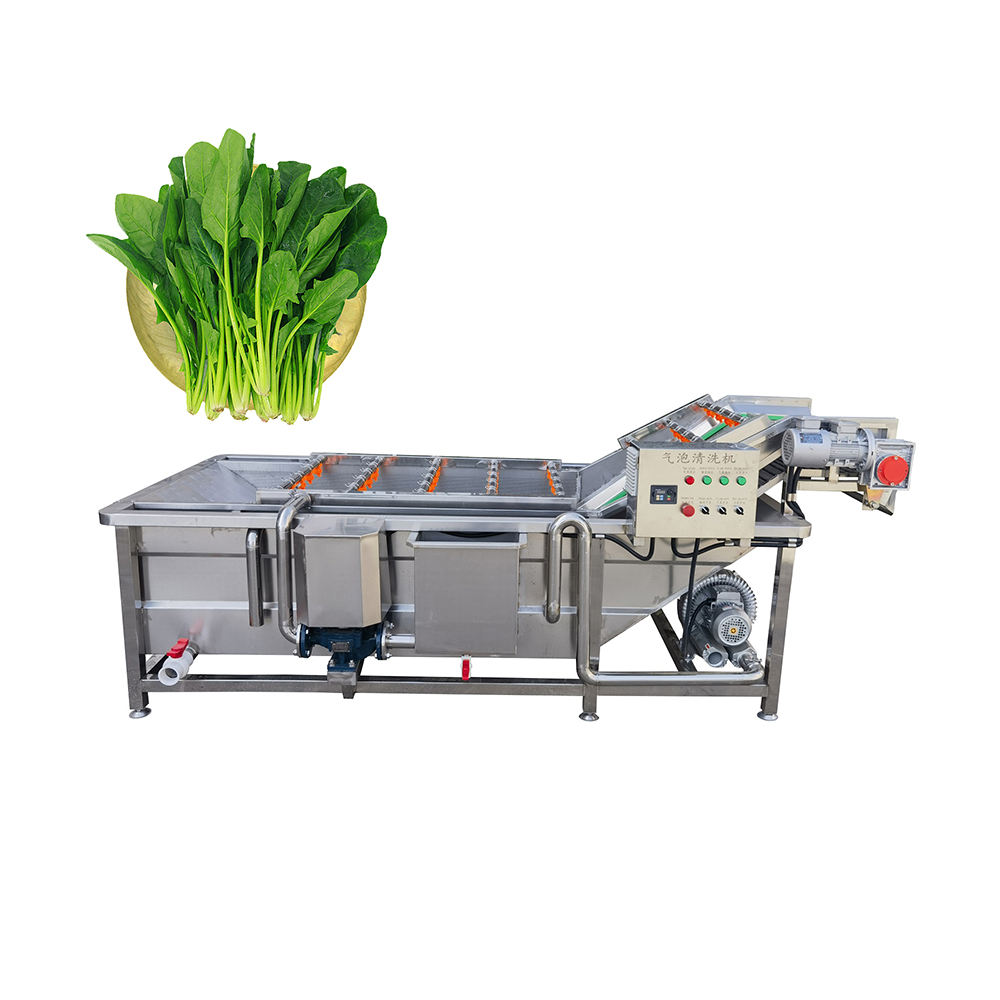1. Introducción
El lavadora de burbujas vegetales y frutas es un equipo avanzado diseñado para limpiar productos frescos utilizando una combinación de inmersión en agua y agitación de burbujas de aire. Este método de limpieza es amable, eficiente, y ecológico, haciéndolo adecuado para productos delicados y firmes.
A medida que los consumidores globales exigen cada vez más listo para comer, precipitado, y productos orgánicos certificados, Los procesadores están pasando del lavado manual tradicional al totalmente automatizado. sistemas de lavado de burbujas.

1.1 Por qué es importante el lavado con burbujas en el procesamiento de alimentos moderno
- Cumplimiento de seguridad alimentaria
Agencias reguladoras como la FDA, Comisión de la UE, y la CFIA exigen a los productores de alimentos que minimicen la contaminación microbiana, residuos de pesticidas, y escombros físicos. - Preservación de la calidad del producto
El lavado con burbujas previene los hematomas, descoloramiento, y pérdida de nutrientes, Especialmente importante para los mercados de exportación.. - Eficiencia operativa
Maneja grandes volúmenes, desde 500 kg/h para plantas pequeñas a 10,000+ kg/h para grandes instalaciones industriales.
2. Cómo funciona una lavadora de burbujas
A Lavadora de burbujas de verduras y frutas. utiliza burbujas de aire generadas por un soplador para agitar suavemente los productos en agua, aflojar la suciedad y los contaminantes.
2.1 El flujo del proceso
- Cargando
El producto ingresa a través de un transportador o tolva manual.. - Inmersión en tanque de agua
Las frutas y verduras están completamente sumergidas.. - Inyección de burbujas
El aire comprimido entra a través de tuberías perforadas., creando turbulencia. - Separación de suciedad
Las partículas pesadas se depositan, los escombros ligeros se alejan flotando. - Enjuague final
Los aerosoles de agua limpia eliminan los contaminantes residuales.. - Descargar
Un transportador transfiere el producto a la siguiente etapa de procesamiento..
2.2 Ciencia clave detrás de la limpieza con burbujas
- Efecto hidrodinámico: Las burbujas crean microcorrientes que penetran los pliegues de las hojas..
- Reducción de la tensión superficial: Las burbujas de aire reducen la adhesión entre la suciedad y producen piel..
- Enriquecimiento de oxígeno: Ayuda a mantener la frescura durante la limpieza..

3. Diseño de máquinas & Componentes
El Lavadora de burbujas de verduras y frutas. está diseñado para durabilidad, higiene, y fácil limpieza.
| Componente | Función |
|---|---|
| Tanque de agua | Holds the washing solution. |
| Soplador de aire | Generates air for bubble production. |
| Mesh Conveyor | Moves produce through the cleaning zone. |
| Sediment Trap | Collects heavy debris. |
| Overflow Outlet | Removes floating impurities. |
| Rinse Section | Provides final clean water spray. |
| Panel de control | Manages speed, air flow, and water circulation. |
Material: SUS304 acero inoxidable (estándar), SUS316 for highly acidic produce.
4. Tabla de parámetros técnicos
| Modelo | Capacidad (kg/hora) | Fuerza (kilovatios) | Water Volume (L) | Dimensiones (milímetros) | Peso (kilos) | Material |
|---|---|---|---|---|---|---|
| DT-500 | 500 | 2.2 | 400 | 3000× 1000 × 1300 | 280 | Sus304 |
| DT-1000 | 1000 | 3.7 | 600 | 4000×1200×1300 | 380 | Sus304 |
| DT-2000 | 2000 | 5.5 | 900 | 5000×1400×1350 | 520 | Sus304 |
| DT-3000 | 3000 | 7.5 | 1200 | 6000×1500×1400 | 650 | Sus304 |
| DT-5000 | 5000 | 11 | 1500 | 8000×1600×1450 | 950 | Sus304 |
5. Product Applications
- Leafy Greens: Lettuce, espinaca, kale, repollo.
- Root Vegetables: Carrots, papas, radishes, beets.
- Fruits: Strawberries, grapes, manzanas, citrus.
- Hierbas: Mint, albahaca, coriander.
- Medicinal Plants: Ginseng, chrysanthemum.

6. Benefits Over Other Washing Methods
| Característica | Lavadora de burbujas | Spray Washing | Manual Washing |
|---|---|---|---|
| Damage to Produce | Muy bajo | Medio | Variable |
| Cleaning Thoroughness | Alto | Medio | Bajo |
| Requisito laboral | Bajo | Medio | Alto |
| Water Use Efficiency | Alto | Medio | Bajo |
7. Guía de instalación
- Select Location – Level floor, near water & drainage.
- Install Utilities – Connect 3-phase power, water inlets, and drainage.
- Assembly – Attach blower, transportador, and rinse sections.
- Testing – Correr con agua sólo para comprobar si hay fugas..
8. Consejos de operación
- Enjuague previamente los productos muy sucios antes de cargarlos..
- Ajusta la intensidad de las burbujas para artículos delicados..
- Mantenga la temperatura del agua baja para mantener la frescura..
9. Programa de mantenimiento
| Frecuencia | Acción |
|---|---|
| A diario | Drenar & tanque limpio, enjuagar filtros. |
| Semanalmente | Inspeccionar el soplador y la bomba.. |
| Mensual | Eliminar escala, desinfectar el tanque. |
| Anual | Reemplazar sellos, aspectos. |
10. Agua & Funciones de ahorro de energía
- Sistema de recirculación reutiliza hasta 80% de agua.
- Eliminación automática de escombros extiende la vida del agua.
- Velocidad variable del ventilador reduce el uso de energía.

11. Estudios de caso
Caso 1 – Procesador de hojas verdes en California
- Capacidad: 3000 kg/hora
- Resultado: Mano de obra reducida por 70%, uso del agua por 40%.
- ROI: Logrado en 14 meses.
Caso 2 – Exportador de Berry en Chile
- Capacidad: 2000 kg/hora
- Resultado: Reducción del daño por hematomas causado por 6% a menos 1%.
12. Tendencias del mercado
- Creciente demanda de productos lavados con certificación orgánica.
- Aumento de la adopción en Asia-Pacífico debido a los mercados de exportación.
- Integración con clasificadoras ópticas.
13. Cómo elegir la máquina adecuada
- Requisitos de capacidad
- Tipo de producto
- Disponibilidad de espacio
- Objetivos de presupuesto y retorno de la inversión
- Soporte para después de las ventas
14. Rangos de precios
- Pequeño (500–1000 kg/h): $2,500–$5,000
- Medio (2000–3000 kg/h): $6,000- $ 10,000
- Grande (5000+ kg/hora): $12,000- $ 20,000+
15. Preguntas frecuentes ampliadas
Q: ¿Se puede utilizar para mariscos??
A: Sí, con protección adecuada contra la corrosión.
Q: ¿Se puede conectar a máquinas peladoras??
A: Sí, comúnmente integrado en líneas de procesamiento completas.
Q: ¿Está disponible la desinfección con ozono??
A: Sí, como complemento opcional.
16. Guía de solución de problemas
| Problema | Causa posible | Solución |
|---|---|---|
| Burbujas débiles | Baja presión del ventilador | Revisar el filtro del ventilador |
| Mala limpieza | Tanque sobrecargado | Reducir la velocidad de alimentación |
| Desbordamiento de agua | Drenaje bloqueado | Salida limpia |
17. Conclusión
A Lavadora de burbujas de verduras y frutas. no es sólo un dispositivo de limpieza, es un productividad, calidad, y la inversión en seguridad. Con el modelo correcto, puedes aumentar el rendimiento, mejorar la higiene, y reducir los costos operativos.
